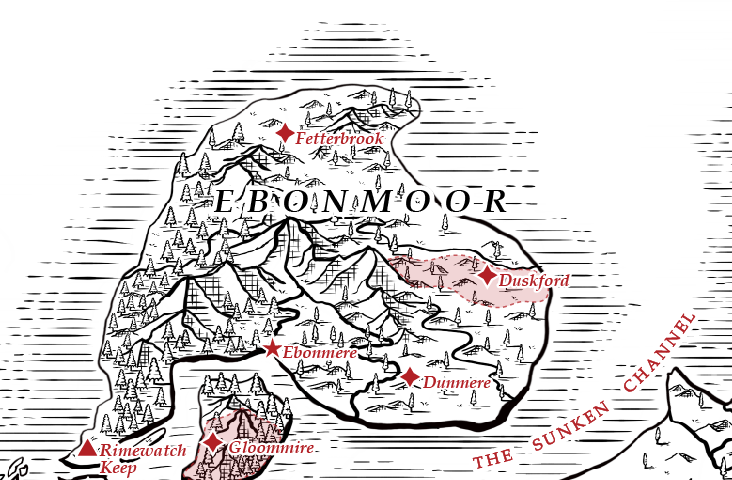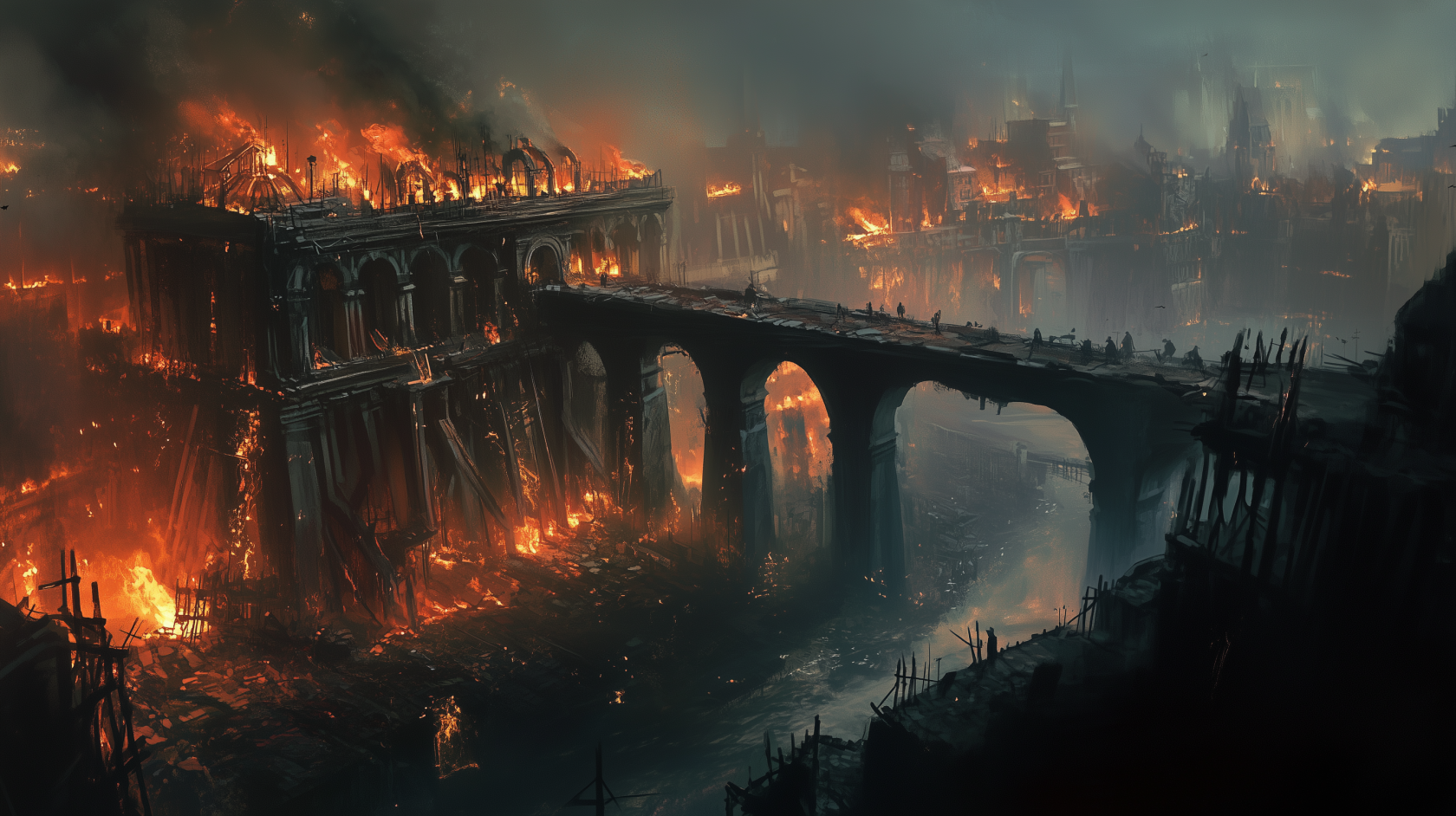Gloommire
The First to Fall
This so-called Blight is just another hardship, no different from famine, war, or the thousand other misfortunes that have come and gone. Gloommire was meant to be the beating heart of Ebonmoor’s future, the bridge—literally and figuratively—that would cement our place in Faulmoor’s prosperity. You don’t halt a project of this magnitude over a handful of sick workers. Trade doesn’t stop, commerce doesn’t stop, and neither will we. The kingdom demands progress, and progress does not yield to fear.
— Master Architect Halvar Roen, Lead Overseer (last recorded statement before the quarantine was enacted)
Gloommire was once a city on the cusp of transformation, a rising star within Ebonmoor that promised to cement the region’s importance in Faulmoor’s future. Positioned on a smaller island just off the mainland, it had long served as a center for timber harvesting and trade, but it was the ambitious infrastructure projects connecting it to both Ebonmoor and Faulmoor that were set to define its legacy. Grand stone bridges, reinforced causeways, and expanding roads were meant to turn Gloommire into a major hub, a gateway between Faulmoor and the outer isles. Workers from across the kingdom—builders, masons, sailors, and merchants—flocked to the city, drawn by the promise of steady work and wealth.
Then came the Rotmire Blight.
At the time, no one truly understood what they were dealing with. Whispers of sickness had spread across Norvostra, but it was always somewhere else—a distant problem, a plague of the desperate and the poor, a misfortune for those who lacked the means to protect themselves. Gloommire, bustling with workers, trade, and noble investment, felt untouchable.
The first cases were dismissed as exhaustion, a natural result of the brutal labor required for the massive infrastructure projects. The workforce had swollen to unprecedented numbers, bringing laborers from across Norvostra—builders, masons, sailors, and merchants who came for opportunity and prosperity. Men collapsing at their posts was not uncommon. Fevers spread in the crowded barracks, and coughs echoed through the timber yards, but no one thought much of it at first. It was the damp air, the hard work, the demands of an expanding city.
Then, they started not getting back up.
The first confirmed outbreak began in the lower districts near the harbors, where the laborers’ quarters stood packed against the waterfront. When the fever took hold, it did not let go. The sick lingered in agonizing delirium, eyes glassy, their breathing heavy and unnatural. Then came the violent convulsions, the blackened veins, the hollow moans that echoed long after their final breath. The first deaths were swift but not unexpected. Sickness, after all, was no stranger to labor camps. It was the return of the dead that shattered any illusions of normalcy.
When the first of the infected rose, clawing their way out of their deathbeds with stiff, unnatural movements, panic ripped through the city like wildfire. At first, many refused to believe what they saw—men they had worked alongside only a day prior moving with jerking, unnatural steps, attacking friends and kin without reason, without recognition. Some of the dead stood motionless for hours, swaying as if listening to something unheard, while others turned immediately, tearing into the flesh of the living before anyone had time to react.
The city’s leadership was unprepared. The local guards, many of whom were laborers themselves, tried to restore order, but how does one fight against something that should not be? Some tried to contain the infected, locking them in buildings, only to hear them scratching at the doors, wailing in the dark. Others attempted to burn the bodies, but by then, the disease had already taken hold across the city.
The noble overseers in charge of the bridge projects sent word to Ebonmere and Faulmoor, begging for assistance, but help never came. The decision had already been made—Gloommire would not be saved.
Ebonmere’s response was immediate and merciless. The first bridge—newly completed—was destroyed within days. Great explosions and fires took it down, cutting off any chance of escape to Ebonmoor. The second bridge, still under construction and nearing completion to Faulmoor, was reduced to rubble soon after. Ships were burned in the harbor, roads leading to the work camps were abandoned, and Gloommire was declared lost. The speed of the containment effort left behind a graveyard of resources—unfinished stone structures, abandoned supply depots, and vast stockpiles of timber, tools, and goods that had once been meant to fuel Faulmoor’s expansion.
Inside Gloommire, the last remnants of resistance collapsed into chaos. Those still alive ran for the forests, only to find the roads abandoned, their camps and supply stations eerily silent. Some sought refuge in their homes, barricading themselves inside, hoping for salvation that would never come. Others tried to fight their way out, only to meet the cold steel of their former allies, unwilling to let the Blight spread further.
And then, silence.
Days passed, and no more messages came from the city. No cries for help, no signals from stranded survivors. Just the wind carrying the distant, low groans of the dead. The fires burned out, leaving only the skeletal remains of once-thriving streets, and the only movement came from shambling figures that now called Gloommire their own.
Though cut off, Gloommire is far from lifeless. It is estimated that thousands of undead now roam the city, shambling between half-finished structures and within the skeletal remains of its fallen bridges. No full-scale expedition has been sent to reclaim the city, for it is deemed too dangerous, and those who do attempt to approach do not return. Outside the city, the surrounding forests and construction sites remain eerily silent. Timber camps and small work settlements, once filled with life, now stand in ruin, their inhabitants either long dead or trapped in the wilderness. Some whisper that there may yet be survivors—stranded workers or isolated families who fled the city before its fall—but Ebonmoor has deemed it a lost cause.
The ruined streets remain strewn with supplies, untouched stockpiles of wood, stone, and metal meant for the bridges that were never completed. Hidden beneath the debris are chests of tools, half-built mechanisms, and caches of untouched provisions, all waiting to be reclaimed. But few dare approach its haunted shores, for the dead do not rest easy in Gloommire, and none know what horrors lurk beyond its ruined gates.
Gloommire, once destined to be the gateway between Faulmoor and Ebonmoor, is now nothing more than a graveyard of broken ambition, a testament to how swiftly progress can become ruin. The bridges may be destroyed, but the city remains, waiting in the mist, its riches still untouched, its horrors still unseen.


